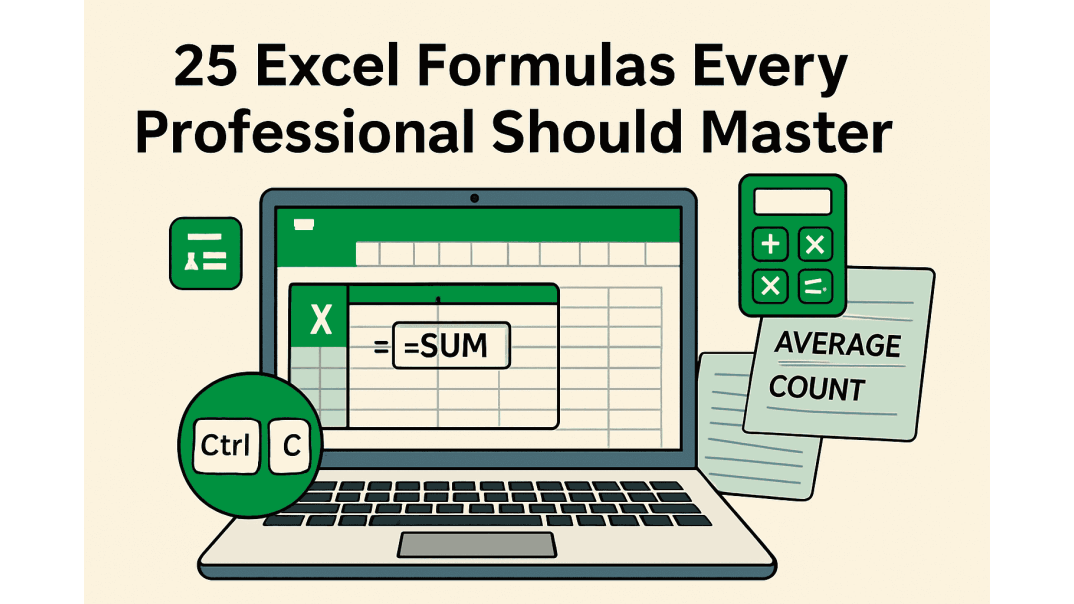Excel is an essential tool in the professional world, streamlining tasks, enhancing productivity, and enabling robust data analysis. Mastering specific Excel formulas significantly boosts your capabilities, transforming data into meaningful insights. This article covers 25 Excel formulas every professional should master, structured for clarity and ease of use.
Getting Started: Essential Excel Skills
Before diving into formulas, it’s crucial to understand Excel’s core concepts, interface, and shortcuts.
Familiarize Yourself with the Excel Interface
Excel’s interface includes key features such as ribbon tabs (Home, Insert, Formulas), the Quick Access Toolbar, and worksheet management. Organizing your workspace efficiently can dramatically enhance your workflow.
Accelerate Workflow with Excel Shortcuts
Learning keyboard shortcuts can significantly increase your productivity. Common shortcuts include:
- Copy: Ctrl + C
- Paste: Ctrl + V
- Save: Ctrl + S
- Navigate worksheets: Ctrl + Page Up/Down
- Select data: Shift + Arrow Keys
Master Basic Excel Functions
Before tackling complex formulas, familiarize yourself with basic functions such as SUM, AVERAGE, and COUNT. These foundational functions will ease your progression to advanced formula use.
Excel Formulas for Data Manipulation and Analysis
Excel formulas are critical tools for performing calculations, analyzing data, automating repetitive tasks, and reducing errors.
Benefits of Excel Formulas:
- Powerful Data Analysis: Easily identify trends, summarize data, and support data-driven decision-making.
- Automation: Reduce manual labor and ensure accuracy.
- Error Minimization: Avoid manual calculation errors to ensure reliable data analysis.
25 Essential Excel Formulas
1. SUM Formula
Quickly sums numbers in a range.
- Example:
=SUM(A1:A10) - Tip: Combine with IF for conditional summation.
2. AVERAGE Formula
Calculates the average of numerical data.
- Example:
=AVERAGE(B1:B10) - Tip: Pair with MEDIAN to effectively handle data outliers.
3. COUNT Formula
Counts cells containing numbers.
- Example:
=COUNT(C1:C10) - Tip: Use with IF to count conditionally.
4. COUNTA Formula
Counts all non-empty cells.
- Example:
=COUNTA(D1:D10) - Tip: Ideal for ensuring data completeness.
5. IF Formula
Performs conditional tests.
- Example:
=IF(E1>100, "Over Budget", "Within Budget") - Tip: Useful in dynamic reporting and financial modeling.
6. VLOOKUP Formula
Looks up and retrieves data vertically.
- Example:
=VLOOKUP(F1, A1:B10, 2, FALSE) - Tip: Critical for accurate inventory or financial data management.
7. HLOOKUP Formula
Performs horizontal data searches.
- Example:
=HLOOKUP(G1, A1:J2, 2, FALSE) - Tip: Essential for datasets arranged horizontally.
8. INDEX Formula
Returns the value of a specified cell within a range.
- Example:
=INDEX(A1:C3, 2, 2) - Tip: Combine with MATCH for dynamic lookups.
9. MATCH Formula
Locates the position of an item in a range.
- Example:
=MATCH("Apple", A1:A10, 0) - Tip: Useful for sorting or ranking data.
10. CONCATENATE Formula
Combines text from multiple cells.
- Example:
=CONCATENATE("Hello", " ", "World") - Tip: Ideal for creating readable reports.
11. TEXT Formula
Formats numbers into text.
- Example:
=TEXT(H1, "0.00") - Tip: Ensures consistent data presentation.
12. LEFT, RIGHT, MID Formulas
Extract specific portions of text.
- Example:
=LEFT(A1,3)=RIGHT(A1,2)=MID(A1,2,4)
- Tip: Perfect for data cleaning.
13. DATE and TODAY Formulas
Efficiently manage date data.
- Example:
=DATE(2023,12,25)=TODAY()
- Tip: Ensures accurate, automated date entries.
14. YEAR, MONTH, DAY Formulas
Extract individual date components.
- Example:
=YEAR(I1)=MONTH(I1)=DAY(I1)
- Tip: Facilitate granular trend analysis.
15. SUMIF Formula
Conditional summation.
- Example:
=SUMIF(J1:J10, ">100") - Tip: Focus your analysis on relevant data segments.
16. AVERAGEIF Formula
Calculates the average based on conditions.
- Example:
=AVERAGEIF(K1:K10,"<50") - Tip: Provides targeted insights into specific data segments.
17. COUNTIF Formula
Counts cells that meet a condition.
- Example:
=COUNTIF(L1:L10,"Yes") - Tip: Ensures data compliance and quality control.
18. IFERROR Formula
Gracefully handles errors.
- Example:
=IFERROR(1/0, "Error") - Tip: Enhances data readability and reliability.
19. ROUND Formula
Rounds numbers to a specified number of digits.
- Example:
=ROUND(M1,2) - Tip: Crucial for financial reporting accuracy.
20. SUMPRODUCT Formula
Multiplies corresponding array elements and sums the results.
- Example:
=SUMPRODUCT(N1:N5,O1:O5) - Tip: Ideal for financial modeling and complex data calculations.
Additional Helpful Excel Formulas
- TRANSPOSE Formula: Reorients data (
=TRANSPOSE(P1:Q1)) - LEN Formula: Measures text length (
=LEN("Excel")) - SUBSTITUTE Formula: Automates text replacement (
=SUBSTITUTE(R1,"old","new")) - INDIRECT Formula: Creates flexible, dynamic references (
=INDIRECT("S1"))
Excel Mastery: Your Path to Professional Growth
Mastering these 25 Excel formulas will significantly boost your productivity and data analysis capabilities. From basic arithmetic operations to complex data manipulation, these formulas equip you with the tools needed for professional success. Start incorporating these formulas into your daily tasks and watch your Excel skills soar!
As you become proficient with these formulas, explore additional Excel features and functions to enhance your capabilities further. Continuous learning and practice will keep your skills sharp and relevant in an ever-evolving professional landscape.
Ready to Upgrade Your Productivity?
Upgrade your productivity and get the latest Office 2024 or Microsoft 365 and unlock the full power of Excel today!
FAQ About 25 Excel Formulas Every Professional Should Master for Productivity
Which Excel formulas should every beginner learn first?
The most important are SUM, AVERAGE, COUNT, IF, and VLOOKUP. These help you add, analyze, and find data quickly in any spreadsheet.
What's the difference between VLOOKUP and INDEX/MATCH?
VLOOKUP finds data by searching the first column of the table. INDEX/MATCH is more flexible, letting you search any row or column, and works even if columns move.
How do Excel formulas help automate repetitive tasks?
Formulas like SUMIF, IF, and COUNTIF can instantly calculate, flag, or summarize data as you enter it, saving time and reducing manual effort.
How can I quickly fix errors in my Excel formulas?
Use IFERROR to hide or manage errors, check for typos and references, and use Excel's Formula Auditing tools to trace and resolve issues.
Which advanced Excel formulas should professionals know?
Learn SUMIFS, COUNTIFS, XLOOKUP, ARRAY formulas, and SUMPRODUCT for more powerful data analysis and reporting as your skills grow.




